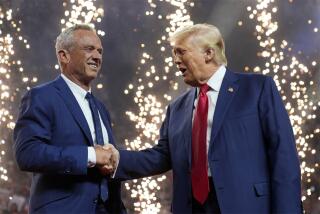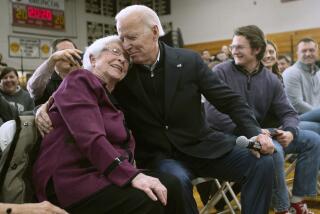Edwards Looking Upstate in Hopes of a New York Surprise
- Share via
NEW YORK — North Carolina Sen. John Edwards may be a new name to many New York Democrats, but to him, the state’s political terrain must look awfully familiar.
Polls here have shown Sen. John F. Kerry of Massachusetts far ahead of Edwards, as is the case in most of Tuesday’s 10 presidential nominating contests. Also as elsewhere, Kerry has been helped in New York by backing from most members of the Democratic establishment.
Edwards, strapped for resources, is pursuing in the state a strategy that parallels his overall plan for Super Tuesday -- picking his spots. He’s focusing on winning at least one or two states and, in New York, on running closer than expected to Kerry.
To accomplish that, he has made a special pitch to the beleaguered working-class communities of upstate New York, hoping to make an impression with his criticism of the “two Americas” he sees divided by wealth and privilege, and with his attacks on trade policies he charges have hurt U.S. workers.
But despite a message that seems tailor-made for the region, Edwards’ prospects for a New York surprise appear dim, political analysts say.
Part of his problem, they say, is that a long economic slump in upstate New York has left weary residents skeptical of yet another politician promising to bring change.
“I don’t think the issue of jobs has as much traction in upstate New York as people would think, in part because it’s not something new,” said Chris Anderson, a political science professor at Syracuse University. “This is not something that has just happened since [President] Bush came to office. People are almost resigned to the fact.”
Even if Edwards is able to generate an enthusiastic turnout in the region, the rules and the numbers are working against him.
New York’s primary is open only to registered Democrats. So far, Edwards’ best performances have come in states where independents also could vote in the party’s contests.
Also, based on past turnout, upstate will account for only about 30% of the Democratic vote, while 70% will come from New York City and its suburbs.
“The problem is there aren’t enough votes up there in the Democratic primary for anyone to win,” said Democratic strategist Hank Sheinkopf.
“It looks like a Kerry romp,” added Maurice Carroll, director of the Polling Institute at Quinnipiac University in Hamden, Conn. A recent institute survey of New York Democrats found Kerry leading by almost 40 percentage points.
Kerry campaigned in New York on Monday and this weekend. But for the most part, he has spent little time in the state.
The crowds that turned out to see him in Harlem and Queens during his Monday stop were meager compared the those he has been attracting in other states. But throughout the day, he was accompanied by a raft of local officials and nearly a dozen members of the state’s congressional delegation. They included Rep. Charles B. Rangel, a well-known African American politician who had backed Wesley K. Clark in the Democratic race until the retired Army general ended his candidacy.
Sens. Charles E. Schumer and Hillary Rodham Clinton of New York have stayed neutral, but otherwise “almost the entire establishment is for Kerry,” said George Arzt, a Democratic consultant. “In a primary, you need the troops out there to get your constituencies to the polls, and in order to do that, you need a strong organization. Kerry has that, and Edwards doesn’t.”
Along with such support, Kerry is benefiting from the momentum of winning 18 of 20 primaries and caucuses.
“Contrary to popular belief, New Yorkers are still part of the continental United States, and they tend to vote with the front-runner,” Sheinkopf said.
Edwards, in zeroing in on upstate New York, made several swings through the area last week and is running television commercials in the region focused on his economic message.
After years of decline, western and central New York should be fertile ground for Edwards’ appeal. In the last century, most of the region’s steel mills were shuttered. More recently, large corporations such as Eastman Kodak, Xerox and Nestle have slashed their workforces or closed their doors completely.
More than 70,000 manufacturing jobs have been siphoned from the area in the last three years, some replaced by lower-paying service-sector jobs.
“People who used to work at steel mills for $25 or $35 [an hour] now work in call centers ... for $8 or $9,” said Lewis Mandell, a professor of finance and economics at the State University of New York at Buffalo.
But voters are divided over which candidate can ignite an economic comeback.
Some prefer Kerry’s experience in Washington and his pledge to stem the export of jobs abroad.
“People are fleeing this region like pigeons, and we’ve got to do something about it,” said contractor Raymond McKnight, 45, as he dissected the political race Friday at Buffalo’s renowned Anchor Bar, home of Buffalo chicken wings.
“John Kerry has a plan. He’s focused. He’s got his mind set on what he needs to do.”
But Edwards, who has served five years in the Senate compared with Kerry’s 19, has argued that someone less entrenched in the ways of Washington would be better-positioned to fight the flight of jobs. Agreeing with that was Pethrod Dunnigan, who also was at the Anchor Bar on Friday.
At 48, the father of two has gone years without health insurance -- so long that he’s afraid to get sick. He said that Edwards speaks his mind about what has to be done.
“We need somebody to come outside Washington limits and shake things up,” he said. “We need somebody in the White House who has been poor -- who knows what it’s like to have gone hungry at some point in his life. That man is John Edwards.”
Eve Shippens, 32, echoed his sentiment.
“The man makes sense,” said the ninth-grade science teacher. “I’ve seen the two disparate Americas he talks about. I work at an inner-city school, and we have nothing. All the money goes to the suburbs, where the richer kids go to school.”
Edwards also has been making a pitch for the supporters of former Vermont Gov. Howard Dean, who had a network of 70,000 activists in the state. Earlier in the year, they gathered a record 105,000 signatures to put Dean on the ballot. Only 5,000 were required.
Ethan Geto, who ran Dean’s operation in New York, said he received nearly 1,000 e-mails from Dean supporters after the former governor dropped out of the Democratic race on Feb. 18. Half said they were still going to cast ballots for Dean, while the other half said they would be giving their support to Edwards.
“They see him [as] less of a Washington insider and not tied to the establishment,” Geto said.
But he added: “Clearly, this race is Kerry’s to lose.”
*
(BEGIN TEXT OF INFOBOX)
New York profile
Polls show John F. Kerry far ahead in Tuesday’s New York Democratic primary, in which 236 delegates are at stake. His main rival, John Edwards, has been focusing on voters in the economically beleaguered upstate area.
Snapshot
*
Population
Statewide: 19 million
Urban residents: 88.2%
Age 65 and older: 10.6%
Median household income: $43,393
Families below poverty line: 11.5%
Families with preschool children below poverty line: 20.2%
*
Ethnicity
White: 62%
Asian: 5.5%
Latino: 15.1%
Black: 15.9%
Native American: 0.4%
Other: 1.1%
*
Party affiliation
Registered Republicans: 27.9%
Registered Democrats: 46.7%
Independents/minor parties: 25.4%
*
Occupation
Management/professional: 33.7%
Sales/office: 27.1%
Production/ transportation of goods: 11.7%
Service: 16.6%
Construction: 7.6%
Farming, fishing and forestry: 0.3%
*
Top exports
Diamonds, paintings, machine and airplane parts, jewelry, circuits, engines
*
Sources: U.S. Census Bureau and Almanac of American Politics -- Graphics reporting by Times staff writer Susannah Rosenblatt
More to Read
Get the L.A. Times Politics newsletter
Deeply reported insights into legislation, politics and policy from Sacramento, Washington and beyond. In your inbox three times per week.
You may occasionally receive promotional content from the Los Angeles Times.










